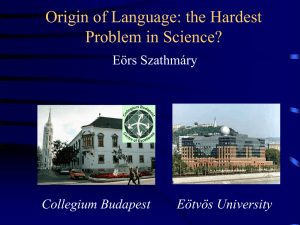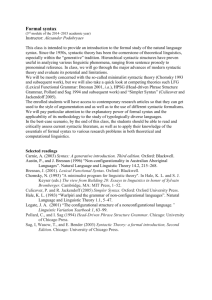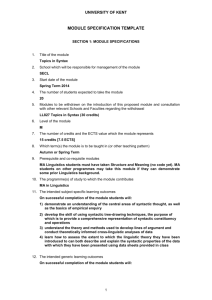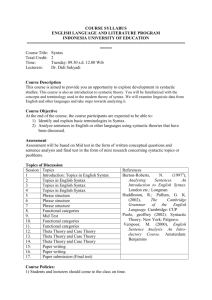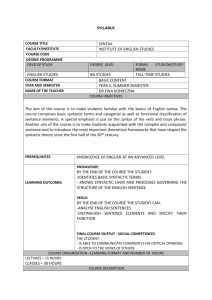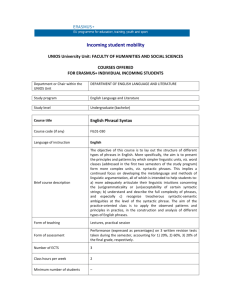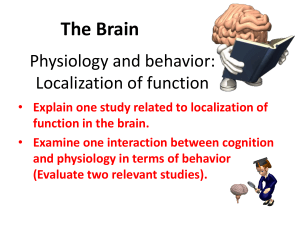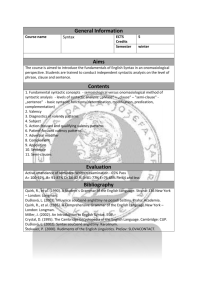Weak Syntax
advertisement
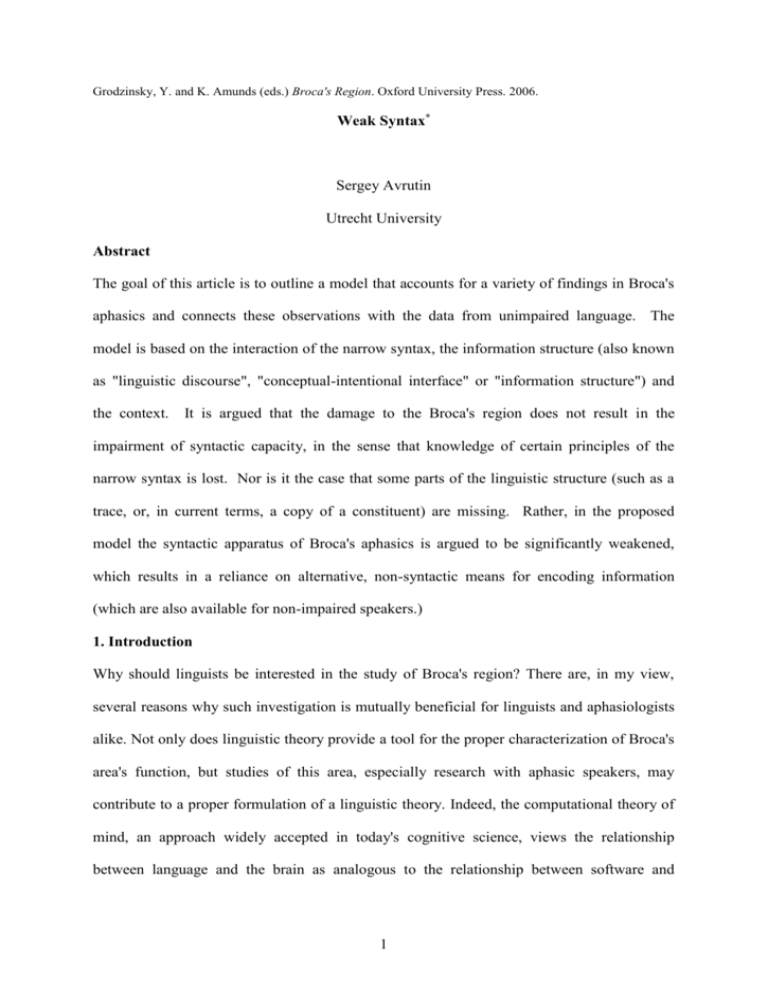
Grodzinsky, Y. and K. Amunds (eds.) Broca's Region. Oxford University Press. 2006.
Weak Syntax*
Sergey Avrutin
Utrecht University
Abstract
The goal of this article is to outline a model that accounts for a variety of findings in Broca's
aphasics and connects these observations with the data from unimpaired language. The
model is based on the interaction of the narrow syntax, the information structure (also known
as "linguistic discourse", "conceptual-intentional interface" or "information structure") and
the context.
It is argued that the damage to the Broca's region does not result in the
impairment of syntactic capacity, in the sense that knowledge of certain principles of the
narrow syntax is lost. Nor is it the case that some parts of the linguistic structure (such as a
trace, or, in current terms, a copy of a constituent) are missing. Rather, in the proposed
model the syntactic apparatus of Broca's aphasics is argued to be significantly weakened,
which results in a reliance on alternative, non-syntactic means for encoding information
(which are also available for non-impaired speakers.)
1. Introduction
Why should linguists be interested in the study of Broca's region? There are, in my view,
several reasons why such investigation is mutually beneficial for linguists and aphasiologists
alike. Not only does linguistic theory provide a tool for the proper characterization of Broca's
area's function, but studies of this area, especially research with aphasic speakers, may
contribute to a proper formulation of a linguistic theory. Indeed, the computational theory of
mind, an approach widely accepted in today's cognitive science, views the relationship
between language and the brain as analogous to the relationship between software and
1
hardware. For any computer to function properly -- and the human brain is, in some sense, a
natural biological computer -- there must be a well-functioning hardware capable of running
particular (domain-specific) software. Theoretical linguistics can thus be characterized as a
study of the natural, language-related software, a study that aims at giving a precise
characterization of the rules the language areas of the brain should be able to support.
Aphasiology, on the other hand, can contribute to the proper formulation of a linguistic
theory in at least the following way. Assume two competing linguistic theories, one of which
lumps two linguistic observations together (e.g. two different types of linguistic
constructions,) while the other suggests that the observed facts are to be explained by
different principles. The two theories would make different predictions about the linguistic
performance of brain damaged patients: the first one would predict a similar performance on
the two constructions (both good or bad), while the other would predict a possible
differentiation1.
Another reason involves the division of labor between various components of
language system. Correct comprehension (and production) involves interplay of various
domains, such as morphology, syntax and discourse. To properly characterize the function of
Broca's region, researchers need to have a clear picture of what kind of linguistic processes
are involved in interpreting a particular structure under investigation.
In this sense,
developments in linguistic theory may have significant consequences for our understanding
of the function of Broca's region. A rather characteristic example in this sense is the pattern
of errors observed in experiments with aphasic patients in their off-line comprehension of
pronominals (e.g., Grodzinsky et al 1993) or in aphasics' errors in on-line studies (e.g. Love
et al 1998). While investigating somewhat different constructions, both of these studies
observed an abnormal pattern of comprehension or activation in these patients.
The
explanations proposed in these studies, however, were based mostly on the theory of
2
anaphora available at that time, that is, Chomsky's Binding Theory (Chomsky 1986).
Specific conclusions about the function of Broca's region were drawn on the basis of that
theory, but it appears clear now that the theory was inadequate and conceptually problematic
(for review see Reuland 2003). More specifically, it has been argued that syntax (or the
"narrow syntax", in current terms) is unrelated to the constraints on pronominals of the type
investigated in the above-mentioned studies.
Thus, the pattern of errors observed
experimentally calls for a non-syntactic explanation, and, consequently, the function of
Broca's region (at least in this regard) needs to be re-considered as including operations
beyond narrow syntax.
The next problem follows immediately. If Broca's aphasics demonstrate some kind of
comprehension deficiency, such as interpretation of passive constructions or object relative
clauses, is it reasonable to attribute this deficit to the disruption of their syntactic machinery?
This question arises because the function of Broca's region in this case becomes rather
undifferentiated: it would have to support processes that, according to theoretical linguistics,
belong to different parts of language architecture.
All else being equal, a characterization of the function of Broca's region should be
able to account for a variety of dysfunctions in a more or less unified way. It seems to me
that researchers often provide a detailed linguistic characterization of some particular
comprehension errors in aphasia without attempting to connect their explanation with the
well-known difficulties in speech production in these patients.
The two modalities --
production and comprehension -- are treated as if they had nothing to do with each other and
as if it were a pure coincidence that one and the same patient (with a particular brain damage
in Broca's region) has an effortful, telegraphic speech, with multiple omissions (or
substitutions) while, in comprehension he or she demonstrates a chance performance on
passive constructions.
3
Finally, a proper formulation of a linguistic theory can explain to what extent
"agrammatism" often attributed to Broca's aphasics represents a case of producing truly
"ungrammatical" utterances. In other words, there is a distinction between an unacceptable
utterance and an ungrammatical one. An utterance can be unacceptable because of variety of
reasons, only some of which are syntactic in nature. As will be demonstrated shortly, what
we often judge as ungrammatical represents, in fact, a case where certain (required)
contextual conditions are satisfied. The sentence is, indeed, unacceptable in a particular case,
but it has nothing to do with grammar: it is grammatically well-formed. This is perhaps a
question of terminology, but if we take the notion of "ungrammatical" to mean something
that violates the rules/principles of the narrow syntax (as I believe researchers often do), we
cannot ignore the fact that some "ungrammatical" expressions typical for Broca's aphasics are
often observed in unimpaired populations as well. To give a brief example (a more detailed
discussion follows below) frequent omission of subjects in the speech of English-speaking
aphasics is a typical characteristic of the diary style register in unimpaired English (for
discussion and examples see Haegeman 1990). Non-finite main clauses, frequently observed
in the speech of Dutch and German Broca's aphasics (e.g. Dutch hij lachen! 'he to-laugh!') are
fully productive (and fully acceptable) in some special registers in these languages (e.g. Kolk
and Heeschen 1992, Blom 2003, Tesak and Ditman 1991, Avrutin 2004, among others.)
Indeed, the range of contextual circumstances when such utterances are used by normal and
aphasic speakers differ significantly, but the point is that by itself such omissions do not go
beyond what is allowed, under certain conditions, in unimpaired language. If so, a proper
formulation of an aphasic syndrome, and hence a better understanding of Broca's area's
functions, has to be provided in such terms that it could explain why allegedly ungrammatical
utterances are allowed in unimpaired speech as well, provided the contextual conditions are
satisfied.
4
2. The Model
2.1. What does the model seek to account for?
As a first step, the proposed model seeks to provide an explanation for the following
observations:
a. Omission of some functional categories, such as determiners and tense, is allowed in
unimpaired speech in many languages that are traditionally assumed to require these
elements. Importantly, however, such omissions are allowed only when specific contextual
conditions are satisfied. Thus, the model needs to show why such omissions are in principle
possible, and why they are restricted to special (context-related) registers.
b. Optional omission of functional categories is a characteristic feature of Broca's aphasics'
speech in languages such as Dutch, German, English, and Swedish. The model seeks to
provide an explanation for why these elements are omitted in aphasic speech and why such
omission is optional (i.e. the same patient sometimes omits and sometimes produces a
determiner.) In addition, the model needs to explain what role the context plays in the
omission pattern in aphasic speech, given that such omissions are allowed in special registers
(see above.)
c. Aphasic speakers demonstrate significantly more errors with tense than with agreement.
The model needs to explain why there is such difference.
d. As discussed below, there is a correlation between omission of determiners and tense in a
given utterance of an aphasic speaker. This correlation needs to be accounted for within the
proposed model.
e. The above observations have to do with speech production. Well-known phenomena of
comprehension (such as poor comprehension of passive constructions and object relative
clauses) need to be explained within the same model.
5
f. The proposed model seeks to connect the above mentioned linguistic observations with
more low-level facts about brain damage, specifically with lower than normal brain
activation. In other words, the goal is to show how diminished available brain resources
results in what may appear to be a structural deficit.
g. As an illustration for the last point, the model seeks to account for recent results on
comprehension of pronouns by Dutch Broca's aphasics. As discussed in section 3, these
patients demonstrate a significantly worse performance precisely in those cases where the
processing economy hierarchy is at stake.
It has to be acknowledged, of course, that at this point it is perhaps impossible to
come up with a truly unifying theory that would connect all experimental and theoretical dots
in a scientifically harmonious way. Clearly, this is not my intention in this article.
Nevertheless, I will attempt to outline a new approach to the investigation of aphasics'
linguistic errors. This model represents a further development of ideas outlined in Avrutin
(1999); its application to the child data is provided in Avrutin (2004).
2.2. Special registers in unimpaired speech.
As mentioned above, omission of functional categories is allowed in unimpaired language,
although only in some restricted contexts. Consider, for example, (1). Taken out of context,
this sentence is unacceptable in English:
1)
*John dance.
However, as noticed, for example by Akmaijan 1984, Tesak and Dittmann 1991, Schütze
1997, among others2, this construction becomes acceptable in the so-called Mad Magazine
register:
2)
John dance???!!! Never!
6
Similar examples exist in Russian and Dutch. A tenseless clause (3) is unacceptable if
produced "out of the blue", but it becomes fully "normal" when it follows, in a given
discourse, a completed event (as in (4)):
3)
*Deti prygat' ot radosti.
[Russian]
Children to-jump[INF] of joy
'children started jumping out of joy"
4)
Ded Moroz prinjos podarki. Deti prygat' ot radosti!
Santa Clause has brought gifts. Children to-jump[INF] of joy!
5)
Maria vertelde Peter een mop. Hij lachen.
Mary told
Peter a
[Dutch]
joke he laugh-inf
Omission of determiners in a language that normally requires them is also possible in a
specific context, as illustrated by the following Dutch examples (from Baauw et al 2002, see
also Tesak and Dittmann 1991.)
6)a.
Q:
Wie heeft jou gisteren gebeld?
‘Who called you yesterday?’
A:
Oh, meisje van school
Oh, girl
b.
from school
Leuk huisje heb je.
nice house have you
Such expressions are fully acceptable and productive, both in Russian and Dutch; however,
they do require specific contextual conditions. For example, Russian non-finite clauses are
possible only if they follow a completed event (see example (4) above.) Dutch determinerless
NPs are acceptable only in specific contexts where there is a sufficient presupposition with
regard to the referent of the NP. Thus, what these examples suggest is that the function of a
functional category can be sometimes taken over by the context. When such conditions are
7
not satisfied, functional elements must be provided in order to make an utterance
interpretable. In the next section I outline a model that will allow us to capture the interaction
between the narrow syntax, information structure and context. I begin with how the proposed
model explains the omission pattern in special registers in unimpaired speech and what role
the context plays in this case. I will extend the application of the model to aphasia in section
2.4.
2.3. From the narrow syntax to information structure and beyond.
Following the basic tenets of the Minimalist Program (Chomsky 1995), I assume that narrow
syntax is a computational system that is isolated and encapsulated with respect to meaning,
that is that such system conducts symbolic operations on lexical items putting them together
in some specific order that is allowed in a given language. The output of this system must be
eventually interpretable. The meaning of lexical items by themselves is clearly not always
sufficient; for example, the interpretation of a pronominal element depends on the
information in the linguistic discourse. Thus, the output of the narrow syntax is submitted to
what Chomsky calls Conceptual-Intentional interface (C-I). In my view, this is precisely the
same level as linguistic discourse, or information structure (as in Vallduví 1992), as it is
precisely here that the information about topic, focus, specificity as well as pronominal
anaphora is encoded.
As will be seen shortly, I distinguish between the notions of linguistic discourse and
the context. The linguistic discourse for me is a level of representation responsible for
resolving (at least some) anaphoric dependencies, identifying topic and focus, determining an
appropriate antecedent for a logophoric element,3 as well as performing other operations
usually referred to as "discourse operations." This system is constructed dynamically in the
course of a given conversation and operates by rules that go beyond a sentence level. What I
mean by context, on the other hand, is a non-linguistic system of thought that can be modified
8
by different means, including, but not limited to, linguistic ones. Thus, the way the term
"discourse" is sometimes used in the literature is, in my view, somewhat confusing as it
encompasses both purely linguistic operations ("linguistic discourse" in my terminology) and
the context. To avoid confusion, I will use the terms "information structure" and "context"
throughout this article.
The Information Structure is part of the computational system involved in language.
Like the narrow syntax that operates on syntactic symbols according to its specific principles,
the Information Structure operates on its own symbols and in accordance with its own rules.
Depending on a particular theory, these symbols can be represented as a discourse
representation structure (DRS, Kamp and Reyle 1993), or a file card (Heim 1982). The point
is that there is, at this level, a basic unit, a chunk of information, that must be made
completely interpretable. This, in fact, may be a non-linguistic requirement: After all, any
communication system, and language is such a system, should be designed in such a way that
it transmits interpretable chunks of information.
In Avrutin 2004, I discuss some constraints (and a possible reason for their existence)
that ensure the well formedness of the information structure. The central idea is that the units
of this system consist of two parts: a frame and a heading. They are introduced, respectively,
by functional and lexical projections from the narrow syntax. The units of information
structure must contain both parts in order to be fully interpretable. A frame ensures that
information units are separated from each other, and a heading provides the information
necessary for interpretation. The diagram below illustrates relationship between narrow
syntax, information structure and other, non-linguistic cognitive faculties, such as context4.
The frame of the unit is supplied by determiner 'a', and the heading is supplied by noun 'dog'.
This entity represents what we may call an Individual Unit of information (or an individual
file card, adapting Heim's 1982 terminology.)
9
PLEASE INSERT FIG. 1 HERE
Similarly, a TP in (7) contains a functional element T and its lexical complement VP.
7)
TP
3
T
VP
+fin
run
As a result of the translation from the narrow syntax into the information structure, we obtain
an event unit of information (or an event file card) represented in Fig. 2 (T supplies the event
heading, and V supplies the heading.)
PLEASE INSERT FIG. 2 HERE
Let us look again at the special register exemplified in (1) - (6). Characteristic of these
examples is that they represent a case where functional categories are missing. Thus, at the
level of information structure, such expressions are unable to introduce frames. At the same
time, as mentioned above, they are fully acceptable, provided certain contextual conditions
are satisfied. That means that certain contextual conditions can take over the function of
functional categories, specifically to introduce a frame. In principle, this should not be
surprising, as the information structure is an intermediate level between the narrow syntax
and our general cognitive capacity, which is involved in constructing the context
representation. Thus, it is reasonable that this interface level may be subject to impact from
either side.
This would make information structure qualitatively different from narrow
syntax, which is fully isolated, autonomous, and encapsulated. As such external conditions
10
cannot influence the well-formedness of a structure in narrow syntax; however, such
influence is possible in information structure. Consider again example (6a). The response is a
determinerless expression, so the narrow syntax does not supply the material necessary for
introducing an individual frame. However, the specific contextual circumstances -- the fact
that the text is a question-answer pair with strong presupposition by the speaker -- allows the
listener to "rescue" the incomplete information unit by alternative means, namely by
inference about speaker's presupposition.
Notice that figures 1 and 2 above represent the process of speech comprehension: the
information units are constructed by the listener on the basis of narrow syntax (e.g. on the
basis of the parser's output.) In the case of special registers, the model should look slightly
different. Indeed, in this case it is more appropriate to describe the process of encoding of a
message by the speaker. Adapting Levelt's (1989) model of speech production, we can
represent the information unit as a message that needs to be encoded by the speaker
(normally through morphosyntax) in order to be transmitted to the listener. I suggest that in
case of special registers some information is presupposed on the basis of a given context, and
therefore does not need to be encoded by linguistic means. In terms of information transfer,
we can say that some information is transmitted through context.
PLEASE INSERT FIG. 3 HERE
A tenseless main clause is similar. As mentioned above, the necessary condition in Russian
seems to be that there is a specific temporal point introduced in the previous linguistic
discourse, to which the new event can be anchored (in terms of Enç 1991).
If the speaker
has provided such a point in the linguistic discourse, it will be part of the context. The
encoding of the temporal information by morphosyntax thus becomes unnecessary, as the
11
listener will be able to infer the temporal information about the tenseless clause, and to
introduce the event frame by non-syntactic means:
PLEASE INSERT FIG. 4 HERE
Crucially, if the discourse condition is not satisfied, a tenseless main clause is unacceptable
because the event information unit has no frame: it has not been provided either by the
narrow syntax or by the context.
Notice that the proposed model makes clear what the context can and cannot do.
Specifically, when a certain element is needed because of the requirements of the narrow
syntax, it cannot be omitted (that is, supplied by the context), because the narrow syntax is an
independent, modular system. Reliance on context is possible only in those cases where the
requirements of the information structure are at stake. A clear example of this distinction is
the respective roles of agreement and tense. As a morphosyntactic characteristic, agreement
must be present because of the narrow syntax requirements. Tense, on the other hand, is
required to make a connection (anchoring) of an utterance to the linguistic discourse (e.g. Enç
1991.) Thus, the model predicts that there will be no register that would allow for omission
of agreement. Indeed, this seems to be the case: while many languages allow a non-syntactic
encoding of the event frame (e.g. non-tensed main clauses), they do not allow omission of
agreement (e.g. no register in Russian would allow a sentence like *deti prygnul
'children[PL] jumped[SING]'.) This feature of the model is important because it makes
further predictions about errors in aphasic speech, discussed below. Briefly, it predicts that
problems with tense should be observed significantly more often than problems with
agreement in the speech of these patients.
12
A question that arises at this point is why "special" conditions would be necessary for
"special registers." In other words, if the possibility of encoding an event or an individual
frame by non-syntactic means is in principle available in natural languages, why don't
speakers always omit functional categories and rely on (often quite reliable) context in order
to build the information units? I would like to propose that the answer is related to economy
considerations. I hypothesize that in normal adult speakers, narrow syntax is the cheapest,
most economical way of encoding individual and event frames and that this is the most
economical way of building information structure5. This is in line with the theory formulated
in Reuland (2001) for unimpaired language. He argues that operations that take place at
different levels (syntax, semantics, discourse) form an economy hierarchy, the syntactic ones
being the cheapest and the discourse ones being the most expensive. Thus, the use of narrow
syntax in unimpaired language for encoding messages follows from its position in the
hierarchy.
2.4. Economy in Broca's aphasia.
The cheapest, most economical option in unimpaired language does not necessarily
enjoy the same status in the language of brain-damaged patients. If Broca's region is involved
with syntactic computations, it is only natural that damage to this area would make these
operations more resource consuming. The economy hierarchy will then be different: what
used to be the easiest way of building information structure, or encoding messages, will now
become more expensive than (or at least equally expensive as) other options in principle
available to the language system. The straightforward reflection of such change in the
economy hierarchy will be noticeable precisely in those cases where, in unimpaired language,
alternative options are avoided because of their relatively higher cost.
13
What I propose therefore is a possible way of what a theory of complexity may look
like if it is to explain certain omissions in production and some specific errors in
comprehension. The main idea is that the resources necessary for conducting syntactic
operations are diminished in Broca's aphasia, with consequences reflected both in the
production pattern and in comprehension errors of these speakers6.
2.4.1. Production
In production, the use of narrow syntax ("the syntactic channel") becomes less
efficient since it is no longer the most economical option available. Rather, an alternative
option is now used, specifically, reliance on the context. Importantly, this option is also
available for unimpaired speakers in special registers. In other words, damage to Broca's
region does not create a new information - processing system. Depending on the degree of
severity of damage, or perhaps on other factors still to be investigated, the two means -syntactic and non-syntactic -- may become comparable with each other in the amount of
information they can encode and transmit. We would then expect to see occasional use of the
syntactic channel, and occasional use of the non-syntactic one. The result is the well-known
phenomenon of variability in aphasic speech.
The proposed model also makes an interesting prediction about the correlation
between omission of determiners and tense. Because such omissions represent the use of nonsyntactic means of transmitting information, the prediction is that once this alternative is
selected by Broca's aphasics, it is likely to be selected for both functional categories. This
prediction is borne out. Baauw et al (2002) presented evidence that there is a correlation
between omissions of these two functional elements. For the utterances of a group of Dutch
speaking Broca's aphasics, it was shown that the more likely a sentence was to contain tense,
the more likely it was that a determiner would also be produced. And the other way round:
tenseless clauses are more likely to contain determinerless NPs. The authors argue that this
14
correlation is due to the optional reliance on non-syntactic means for introducing information
units: if a non-syntactic root is chosen (as the easiest in the sense discussed above), it is more
likely to fulfill all functions with regard to encoding a message, both for individual and event
information units7.
As discussed above, the ability of the context to compensate for what has not been
encoded morphosyntactically is limited. If a certain element of the structure is required
because of the requirements of the narrow syntax (a modular, independent computational
system), this element cannot be omitted. Again, for example, there is no register such that
allows mismatch in agreement. The prediction about Broca's aphasics is then that these
patients would make significantly fewer errors with agreement than with tense, because there
is no alternative way to encode agreement rather than by means of morphosyntax. Indeed, as
many authors have argued, there is a difference in aphasics' performance with respect to these
two elements. Friedmann 1999, Benedet et al. 1998, Kolk 2000, and Wenzlaff and Clahsen
(in press), among others, show that Hebrew, Dutch and German speaking Broca's aphasics
are more impaired with tense than with agreement. Given that in many cases these patients
produce a non-finite verb, the results support the proposed model.
To continue this line of argument about what the context can and cannot do, it is
important to remember that the speech of Broca's aphasics is not overall impaired. It has
been demonstrated that these patients are sensitive to some subtle syntactic constraints.
Bastiaanse and Zonneveld (1998), for example, show that the use of non-finite forms in
aphasics is restricted to the main clause (the authors’ claim being that agrammatics have
problems with verb movement that takes place in Dutch only in the main clause; see
however, Lonzi and Luzzatti 1993). When asked to complete a sentence with a missing verb,
agrammatics produced finite forms only 49% of the time; in embedded clauses, however,
their performance increased to 86%. Avrutin (1999) suggests that these findings demonstrate
15
patients' sensitivity to what Gueron and Hoekstra (1995) label "the tense chain," the
requirement on the coindexation of Comp and T. Thus, they preserve the subtle syntactic
knowledge that in the presence of overt Comp, only finite T can participate in the tense chain.
Further support for this view comes from the observation that these speakers always produce
tensed auxiliary verbs and modals (even in the main clause), the elements that head TP and
therefore occur in the tense chain (e.g. Bastiaanse and Jonkers 1998, Kolk 1998, De Roo
1999)8.
Broca's aphasics also demonstrate subtle syntactic knowledge of the relationship
between verb movement and finiteness. Kolk and Heeschen (1992) show that if a non-finite
verb is produced by a Dutch or German (V2 languages) aphasic speaker, this verb, in the vast
majority of cases, is in the clause final position; a finite verb is always correctly placed in the
second position. Lonzi and Luzzatti (1993) report similar results for Italian Broca's aphasics.
The authors observe that when the verb is nonfinite, it either precedes or follows the adverb
(both positions are correct in Italian), but when the verb is finite, the adverb always follows
it.
As for comprehension, which I will discuss shortly, Broca’s aphasics do not differ
from normal speakers in their sensitivity to a verb’s representational complexity. Thus, as
Shapiro et al (1987) demonstrate, it takes longer for normal speakers to process verbs that
have more possible argument structures (e.g. alternating datives such as ‘send’ take more
resources than a transitive verb such as ‘fix’). Following up on this study, Shapiro and
Levine (1990) showed that Broca’s aphasics exhibit a similar pattern of performance: while
their reaction, overall, is significantly slower than normal, the same distinction between verbs
with regard to the argument structure complexity can be detected in these patients.
Interestingly, the above findings represent precisely those cases where the context
cannot serve as an alternative. Verb movement, for example, is triggered by the principles of
16
narrow syntax and has no direct consequences for building of information structure.
Moreover, there is no register in unimpaired Dutch or German that would allow a non-finite
verb in the second position.
These observations further support the claim that the
"agrammatic" performance exhibited by Broca's aphasics does not constitute impairment of
grammar (taken here to mean principles of narrow syntax.) Their errors are restricted to those
cases that can be characterized as reliance on alternative means of building information
structure (in comprehension) or encoding a message (in production.) If this alternative is not
available, these patients will produce, perhaps slower than in unimpaired speech,
syntactically well-formed utterances.
A natural question is why functional categories are more vulnerable than lexical ones.
First of all, notice that omission of functional categories is compatible with some registers in
unimpaired language, while there is no register that would allow optional omission of a
lexical element (e.g. even if we know from a given context that the conversation is about a
specific boy who read some book, it is impossible to say "the ... read a ...") Simply speaking,
lexical elements are too informative to be omitted. In terms of Shannon's information theory
(Shannon 1948), these elements are selected from a larger set compared to the functional
categories, which makes them, in the technical sense, "more informative." Avrutin (in
preparation) provides more discussion of how a formal information theory can be integrated
into current psycholinguistic research. Suffice it to say that the amount of information an
element has is proportional to the degree of activation it receives, and therefore is less likely
to be omitted. The same kind of reasoning explains why in some languages aphasic patients
demonstrate substitution patterns rather than omissions. These are usually morphologically
rich languages; thus each form is to be selected from a larger set of related elements (a
somewhat similar, processing-based account is offered in Lapointe 1985.) This fact makes
17
them more informative, with direct consequences for processing cost and activation (for more
discussion of such relationship in unimpaired speech see, for example, Kostic et al (in press))
2.4.2. Comprehension
In order to illustrate how the proposed model explains comprehension deficiency in Broca's
aphasia, I will now discuss some experimental findings that can be straightforwardly
explained in terms of a competition between two systems. It is certainly beyond the scope of
this article to address all findings in aphasia; the ones presented below will simply serve as an
illustration of the application of the model.
A typical case where economy considerations determine a possible interpretation is
the so-called Exceptional Case Marking constructions (ECM) illustrated in Dutch example
(8) (SE stands for 'simplex expression: a monomorphemic element that is always referentially
dependent on an antecedent in the same sentence.)
8)
Jani zag [zichi / *hem i dansen]
John saw [SE/him dance]
Reuland (2001) in his Primitives of Binding framework argues that various types of anaphoric
dependencies form an economy hierarchy in such a way that a more costly dependency is
disallowed, provided a cheaper alternative is available. For example, Dutch anaphor 'zich' can
enter a syntactic dependency with its antecedent as a result of feature checking. Pronouns, on
the other hand, are unable to participate in this type of dependency because, unlike simplex
expression 'zich', they possess a number feature that cannot be deleted. Thus, no syntactic
dependency can be formed for a pronoun. There are, of course, other dependencies in natural
language, e.g., discourse dependency where 'Jan' and 'hem' would receive the same value
from discourse storage9:
9)
Jan zag hem dansen -------------> zag (x, (dansen (y)); x=y
John saw him dance
18
However, according to Reuland's hierarchy, a discourse dependency is more expensive than a
syntactic one. Thus, it is disallowed on the basis of economy considerations.
If the narrow syntax is "weakened" and is no longer the most economical option, the
hierarchy proposed by Reuland changes.
If so, there should be no prohibition against
establishing a non-syntactic dependency between the antecedent and a pronoun in (9).
Ruigendijk et al (2003) have recently demonstrated that indeed Dutch speaking Broca's
aphasics show an impaired pattern of responses. In a picture selection task, subjects were
presented with sentences such as in (10) and three pictures corresponding to the correct
choice of an antecedent, an incorrect one, and a filler.
Each sentence began with an
introductory clause of the form ‘First the boy and the man drank something and …’ (in order
to make two possible antecedents available) and concluded with the following:
10)
… daarna zag de man hem voetballen
[Dutch]
… then the man saw him playing soccer
The correct picture showed a boy playing soccer in front of the mirror, and a man looking at
the boy. The incorrect picture showed a man playing soccer in front of the mirror looking at
himself. Thus, if a listener disallows coreference between 'him' and 'the man', he/she should
choose the correct picture. If he/she allows 'him' to refer to the matrix subject, the incorrect
picture could be chosen.
Adult controls correctly chose the picture where the man sees the boy in the mirror.
Aphasic speakers, however, incorrectly pointed to the picture where the boy sees himself
around 50% of the time, which is not different from chance10. In other words, they quite often
allowed a local dependency relation between the pronoun and the matrix subject. The authors
argue that since the syntactic dependency is the less economical one for this population, they
may sometimes allow a semantic or discourse dependency between the matrix subject and the
pronoun. Notice that such allowance is once again "optional" -- it is not the case that subjects
19
always select this picture.
This is not surprising, however, because, as in the case of
production, the errors result from the competition between two systems -- the narrow syntax
and an alternative that is the context. For some speakers, one system can win on some
occasions, and the other will take over in other cases, which results in an overall chance
performance11.
The above results show that Broca's aphasics sometimes fail to establish a
dependency relation between an antecedent and a pronoun correctly.
Other results
concerning dependency between two positions involve passive constructions and object
relatives. The abnormal, chance-level comprehension of agrammatic Broca's aphasics on
passive constructions is well known. As discussed extensively in Grodzinsky 1990,12 a
typical observation is that Broca's aphasics choose at a more or less chance level between 'the
cat' and 'the dog' as the agent of the chasing event in the following sentence.
11) The cat was chased by the dog.
Grodzinsky's trace deletion hypothesis (TDH) suggests that aphasic patients are unable to
represent traces, so a trace in the object position of the verb 'chase' is deleted. As a result, the
subject DP does not receive the agent theta-role (as it should in an unimpaired linguistic
structure), and, since each DP must have a theta role in order to be interpreted, the subject
receives an interpretation by means of some kind of strategy that assigns, at least in English,
the agenthood to the first DP in the sentence. Alternative explanations for this phenomenon
were offered, among others, by Piñango (1999) who argues that the impairment is restricted
to mapping between syntactic and semantic structures.
Notice however that the phonologically empty element in the object position (a trace,
or a copy) normally enters a syntactic dependency with the subject. This dependency may be
represented as a syntactic chain, or as some other mechanism that would link the two
positions in narrow syntax. I suggest, however, that such dependency must be established in a
20
timely fashion, that is very fast, in a normal case, in order to function as a reliable source of
interpretation. Syntactic operations, however, are slowed in aphasia, as demonstrated
convincingly by Zurif et al (1993) and Swinney (2003)13. These researchers showed that
Broca's aphasics show priming for an antecedent significantly later than normal controls. The
main point thus is that the syntactic dependency is, in principle, intact in aphasia; however,
the necessary syntactic connection is significantly slowed down14. In terms of the proposed
model, we can interpret these findings as evidence for the lack of necessary resources for
conducting syntactic operations in time because, as in any other physical system, speed is a
function of available energy; in other words it is proportional to the available brain activation.
As the syntactic system is no longer the most economical (and hence the cheapest one) for
these patients, they may sometimes avoid reliance on narrow syntax when interpreting
passive constructions. As the first DP in a passive construction is usually the most prominent
element, a topic, and as there is a general correlation between topichood and agency (as also
pointed out by Grodzinsky in his formulation of aphasics strategy), the information unit
introduced by the first DP may end up marked as the agent. Once again, there is a
competition between the two systems. Depending on which system wins, patients will either
choose a correct interpretation (subject=patient), or an incorrect one (subject=agent.)
Overall, we observe a chance performance15.
Finally, the proposed model makes the prediction that the chance performance in
comprehension will be observed in Broca's aphasics only in cases where
competition
between the syntactic and discourse-related operations may take place. As discussed above
for production, when no alternative is possible, and the application of a syntactic operation is
required, these patients are predicted to show an above chance performance. A clear example
of such a situation in comprehension is the case of wh-questions. Hickok and Avrutin (1995)
21
and Tait et al (1995) show that Broca's aphasics performed above chance on object WHOquestions (as in (12)) but around chance on object WHICH-questions (as in (13))16.
12) Who did the cat chase?
13) Which dog did the cat chase?
WHO-questions differ from WHICH-questions in that only the latter is discourse-linked.
Specifically, the wh-phrase 'who' functions as a pure operator and is not represented by a
discourse referent.
The wh-phrase 'which dog', on the other hand, does have such a
representation, since it presupposes the existence of a known set of dogs. Importantly, thus,
only in (13) is a discourse link between the object position and the wh-phrase is possible; for
who-questions the only option is to establish the connection in syntax. Broca's aphasics
demonstrated a good performance on the "pure syntactic" question, while showing a chance
performance on the condition where a competition between two systems (syntactic and nonsyntactic) was in principle possible. Given that their syntactic system was weakened, they
would occasionally rely on a non-syntactic one, which resulted in a an overall chance
performance in the same way as in the case of interpreting ECM constructions or passive
sentences.
4. Summary
As a result of damage to Broca's region, the amount of resources necessary for
conducting operations involving narrow syntax is diminished. This causes a slow down in
the process of speech production.
Moreover, reduced power of this system (a direct
consequence of diminished resources) may result, at least sometimes, in the situation where
alternative systems become more powerful, and therefore are used for the purposes of
building information structure in comprehension, or encoding a message (in production: an
option available, in principle, in unimpaired language.17)
22
Impairment in Broca's aphasia is not limited to structures involving constituent
movement (e.g. passive constructions, object relative clauses.) Comprehension of pronouns
and other determiners causes difficulties as well. Slow, effortful, telegraphic speech is
characteristic of the same patients who demonstrate problems with comprehension of certain
elements. The unified explanation of these phenomena presented here is based on the claim
that the power of the damaged Broca's region is diminished, with direct consequences both
for production speed and economy-based errors in comprehension.
In order to produce speech in normal time, and to rely on narrow syntax for the
purposes of conveying and processing information, speakers need to have strong, powerful
syntactic apparatus capable of performing required operations in time. As a result of brain
damage, the power available to this system is reduced, and the syntax becomes weak.
23
References
Akmaijan, A. 1984. Sentence type and form-function fit. Natural Language and Linguistic
Theory, 2, 1-23.
Avrutin, S. 1999. Development of the syntax-discourse interface. Dordrecht, Kluwer
Academic Publishers.
Avrutin, S. 2000. Comprehension of D-linked and non-D-linked wh-questions by children
and Broca’s aphasics. In: Language and the brain (Y. Grodzinsky, L. Shapiro and D.
Swinney, Eds.), San Diego, Academic Press, 295-313.
Avrutin, S. 2004. Optionality in child and aphasic speech. Lingue e Linguaggio, 1, 67-89.
Baauw, S. E. de Roo, and S. Avrutin. 2002. Determiner Omission in Language Acquisition and
Language Impairment: Syntactic and Discourse Factors. Proceedings of the Boston
University Conference on Language Development. Boston, Cascadilla Press, 23-35.
Bastiaanse, R. and R. Jonkers. 1998. Verb retrieval in action naming and spontaneous speech
in agrammatic and anomic speech. Aphasiology 12, 951-969.
Bastiaanse, R. and R. van Zonneveld. 1998. On the relation between verb inflection and verb
position in Dutch agrammatic aphasics. Brain and Language, 64, 165-181.
Benedet, M.J., Christiansen, J.A. and H. Goodglass, H. 1998. A cross-linguistic study of
grammatical morphology in Spanish- and English-speaking agrammatic patients. Cortex,
34, 309-336.
Blom, E. 2003. From root infinitive to finite sentences. Doctoral dissertation, Utrecht
University, The Netherlands.
Caramazza, A. and E. Zurif. 1976. Dissociation of algorithmic and heuristic processes in
language comprehension: Evidence from aphasia. Brain and Language, 3, 572-82.
Chomsky, N. 1981. Lectures on government and binding, Dordrecht, Foris.
24
Chomsky, N. 1986. Knowledge of Language, New York, Praeger.
Chomsky, N. 1995. The Minimalist Program. Cambridge, MIT Press.
De Roo, E. 1999. Agrammatic Grammar, Doctoral dissertation, Leiden University.
Enç, M. 1991. Anchoring Conditions for Tense. Linguistic Inquiry, 18, 633-57.
Friedmann, N. 1999. Functional categories in agrammatic production: a cross-linguistic
study. Doctoral dissertation, Tel Aviv University, Israel.
Grodzinsky, Y. 1990. Theoretical perspectives on language deficit. Cambridge, MIT Press.
Grodzinsky, Y., A. Pierce and S. Marakowitz 1991. Neuropsychological reasons for a
transformational derivation of syntactic passive. Natural Language and Linguistic
Theory.
Grodzinsky, Y. 1999. The neurology of syntax: Language use without Broca’s area. Brain
and Behavioural Science, 23, 47-117.
Grodzinsky, Y., K. Wexler, Chien, Y.-C., S. Marakovitz & J. Solomon. 1993. The breakdown
of binding relations. Brain and Language, 45, 371-395.
Gueron, J. & T. Hoekstra. 1995. The temporal interpretation of predication. In Syntax and
Semantic 28 (A. Cardinalletti and T. Guasti, Eds.), San Diego, Academic Press.
Haegeman, L. 1990. Understood subjects in English diaries: on the relevance of theoretical syntax
for the study of register variation. Multilingua, 9, 157-99.
Heim, I. 1982. The Semantics of Definite and Indefinite Noun Phrases, Doctoral
Dissertation, Amherst, University of Massachusetts.
Hickok, G. and S. Avrutin. 1995. Representation, Referentiality, and Processing in
Agrammatic Comprehension: Two Case Studies. Brain and Language, 50, 10-26.
Hofstede, B. 1992. Agrammatic speech in Broca’s aphasia; Strategic choice for the elliptical
register, Doctoral dissertation, Nijmegen Institute for Cognition and Information.
Kamp H. and U. Reyle 1993. From Discourse to Logic, Dordrecht, Kluwer Academic.
25
Kolk, H. 2000. Canonicity and inflection in agrammatic sentence production. Brain and
Language, 74, 558-560.
Kolk, H.H.J. and C. Heeschen 1992. Agrammatism, paragrammatism and the management of
language. Language and Cognitive Processes, 7, 89-129.
Kolk, H.H.J. 1998. Disorders of syntax in aphasia. In: Handbook of neurolinguistics (B.
Stemmer and H. Whitaker, Eds.), San Diego, Academic Press, 249-260.
Kolk, H.H.J. 1995. A time-based approach to agrammatic production, Brain and Language,
50, 282-303.
Kostic, A. (in press) The effects of the amount of information on processing of inflected
morphology. Manuscript, University of Belgrade.
Levelt, W.J.M. 1989. Speaking: From Intention to Articulation. Cambridge, MIT Press.
Lapointe, S. 1985. A theory of verb form use in the speech of agrammatic aphasics. Brain
and Language, 24, 100-185.
Lonzi, L. and C. Luzzatti. 1995. Omission of prepositions in agrammatism and universal
constraint of recoverability, Brain and Language, 51, 129-32.
Love, T., J. Nicol, D. Swinney, G. Hickok & E. Zurif. 1998. The nature of aberrant
understanding and processing of pro-forms by brain-damaged populations. Brain and
Language, 65, 59-62.
Piñango, M. 1999. Syntactic displacement in Broca’s aphasia comprehension. In:
Grammatical disorders in aphasia: a neurolinguistic perspective (Y. Grodzinsky and
R. Bastiaanse, Eds.), London, Whurr, 75-87.
Piñango, M.M. 2000. Neurological underpinnings of binding relations. Paper presented at the
linguistic society of Germany, Marburg, Germany, March 2.
26
Piñango, M., P. Burkhart, D. Brun and S. Avrutin. 2001. The Architecture of the Sentence
Processing System: The Case of Pronominal Interpretation. Paper presented at
SEMPRO meeting, Edinburgh, UK.
Piñango, M. and P. Burkhardt. 2001. Pronominals in Broca’s aphasia comprehension: the
consequences of syntactic delay. Brain and Language, 79, 1, 167-68.
Reuland, E. 2003. A window into the architecture of the language system.
GLOT International, 7, No 1/2.
Reuland, E. 2001. Primitives of binding. Linguistic Inquiry, 32, 439-92.
Ruigendijk, E. 2002. Case assignment in Agrammatism. Doctoral dissertation, Groningen
University.
Ruigendijk, E., S. Baauw, S. Zuckerman, N.Vasić, J.de Lange and S. Avrutin. 2003. A crosslinguistic study on the interpretation of pronouns by children and agrammatic
speakers: Evidence from Dutch, Spanish, and Italian, Paper presented at CUNY
sentence processing conference, Boston.
Shapiro, L. and B. Levine. 1990. Verb processing during sentence comprehension n aphasia.
Brain and Language, 38, 21-47.
Shapiro, L., Zurif, E. and J. Grimshaw. 1987. Sentence processing and the mental
representation of verbs. Cognition, 27, 219-246.
Swinney, D. J. Nicol & E. Zurif. 1989. The effects of focal brain damage on sentence
processing: an examination of the neurological organization of a mental module.
Journal of cognitive neuroscience, 1, 25-37.
Swinney, D. 2003. Psycholinguistic approaches. Paper presented at the 4th Science of
Aphasia conference, Trieste.
Tait, M.E., Thompson, C.K. and K.J. Ballard. 1995. Subject-object asymmetries in
agrammatic comprehension of four types of wh-questions. Brain and
27
Language, 51, 77-79
Tesak, J. and J. Dittmann. 1991. Telegraphic style in normals and aphasics. Linguistics, 29,
1111-37.
Vallduví, E. 1992. The informational Component, New York, Garland.
Zurif, E.B. 2003. The neuroanatomical organization of some features of sentence processing:
Studies of real-time syntactic and semantic processing. Psychologia, 32, 13-24.
Zurif, E.B., D. Swinney, P. Prather, J. Solomon and C. Bushell. 1993. An on-line analysis of
syntactic processing in Broca’s and Wernicke’s aphasia. Brain and Language, 44864.
Wenzlaff, M and H. Clahsen (in press). Finiteness and Verb-Second in German
Agrammatism.
28
Narrow Syntax
Information structure
Context
(" linguistic discourse",
"C-I interface")
D: a
FRAME
NP: information
?
Heading: dog
dog
Fig. 1: Normal way of introducing an individual information unit for DP 'a dog'.
Narrow Syntax
Information structure
Context
(" linguistic discourse",
"C-I interface")
T:
FRAME
?
past tense features
VP: information
Heading: run
ran
Fig. 2: Normal way of introducing an Event Unit of information.
29
Context
Special registers:
Individual frame encoded through presupposition
Information structure
(message)
(" linguistic discourse",
"C-I interface")
FRAME
Heading: meisje
Narrow Syntax
NP: information
meisje ('girl')
Fig. 3. Non-syntactic way of encoding an individual frame.
30
Context
Special registers:
Event frame encoded through presupposition
Information structure
(message)
(" linguistic discourse",
"C-I interface")
FRAME
Heading: prygat' (to jump)
Narrow Syntax
VP: information
Prygat' (to-jump)
Fig. 4. Non-syntactic way of encoding an event frame.
31
*
The preparation of this publication was supported by the Dutch National Science
Foundation (NWO) as part of the Comparative Psycholinguistics research program. I thank
Sergio Baauw, Yosef Grodzinsky, Joke de Lange, Esther Ruigendijk, Nada Vasic and Shalom
Zuckerman for their comments. Special thanks are due to Jocelyn Ballantyne for proofreading the manuscript.
1
For example, Grodzinsky et al (1991) used evidence from Broca's aphasics to distinguish
between two theories of passive constructions. They demonstrated that these patients are
selectively impaired in those constructions that, according to one of the competing theories,
involve syntactic transformations.
2
Haegeman (1990) also shows that omission of subjects in a non-pro drop language such as
English is possible in some specific "diary style" registers.
3
Recent work by Cole et al 2001 is particularly interesting in this regard as it shows that the
choice of an antecedent for a logophor can be parameterised with value of parameters
different in different dialects. This evidence demonstrates that the level of "discourse" is,
indeed, linguistic in nature and that the term "linguistic discourse" is rather appropriate.
4
I put a question mark under "context" as I remain agnostic with regard to the type of
symbols and the structure of context as a cognitive system.
5
In this sense, the notion of economy that has played a major role in recent theoretical work
(e.g. Chomsky 1995, Reuland 2001) is more than a formal notion. In my view, it should
reflect, at some level, the amount of resources utilized by the brain when performing a
specific computation. In Avrutin (2000) I discuss experimental evidence supporting the claim
that the narrow syntax operations are the cheapest. For further evidence see also Piñango et al
(2001).
32
6
The reduction of resources, and a consequent slow-down of the syntactic machinery are
most likely due to problems with lexical access in Broca's aphasia, as argued by many
researchers (e.g. Zurif 2003, Shapiro and Levin 1990, Swinney et al 1989, among others.)
7
For a somewhat different explanation of these data see Ruigendijk (2002).
8
The same approach explain the omission of complementizers in aphasics' speech. Since
Comp and T form a chain, omission of one element necessitates omission of the other in
order to avoid an invalid chain formation.
9
Once again, there is a discrepancy in terminology. What Reuland (2001) refers to as
"discourse dependency" is, in my terminology, a dependency at the level of information
structure ("linguistic discourse") established by reliance on contextual information. Reuland's
notion of
"discourse storage" should be viewed as part of the context in the present
terminology.
10
When in the same construction the pronoun is replaced with 'zichzelf', the patients
demonstrated an almost perfect performance. Thus, their problem is not related to ECM
constructions per se, but rather to the interpretation of a pronoun in such constructions.
11
Another reason is that there is always a choice between two pictures; that is even if
subjects allow for a discourse dependency between the matrix subject and the pronoun, they
don't have to make this choice: it is always possible to interpret the pronoun as referring to an
external antecedent.
12
Grodzinsky (1999) provides a more general picture of the role of Broca's area in
comprehension of structures involving transformations. For expository purposes, I will focus
here on passive constructions, although, I believe, the account can be extended to relative
clauses and clefts.
13
Other results that are relevant are reported in Swinney et al 1989 who showed that Broca's
aphasics exhibit abnormal pattern of activation of word meaning. In a study with ambiguous
33
words, these researchers show that Broca's aphasics are capable of accessing only the most
frequent meaning of the word within the initial, short period of time. Later on, however, both
meanings become available.
14
Further evidence that Broca's aphasics maintain a normal ability to connect two position in
a syntactic tree but in a slower-than-normal way is presented in Piñango and Burkhardt
(2001).
15
The same explanation also holds for the chance performance observed in object relative
clauses, as in pioneering work of Caramazza and Zurif (1976).
16
Performance on both types of subject wh -questions was above chance, as predicted
because in this case the information about the thematic role of the unmoved object is
sufficient to obtain a full interpretation.
17
Another population that exhibits performance similar to that of Broca's aphasics is
normally developing children. See Avrutin (2004) for more discussion and the application of
the proposed model to child speech.
34
